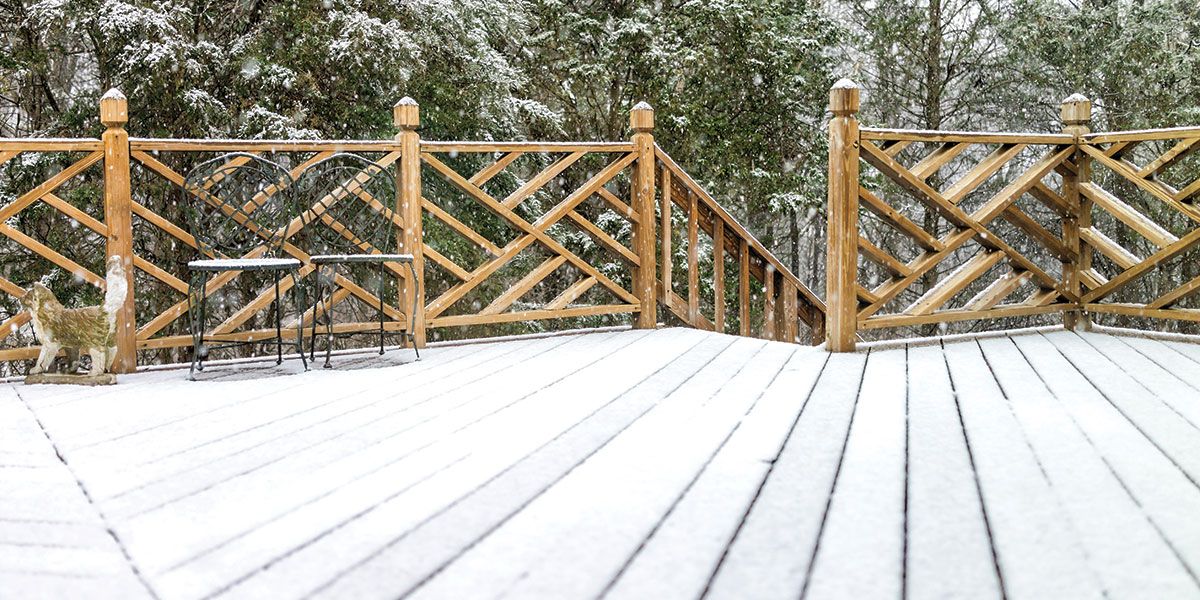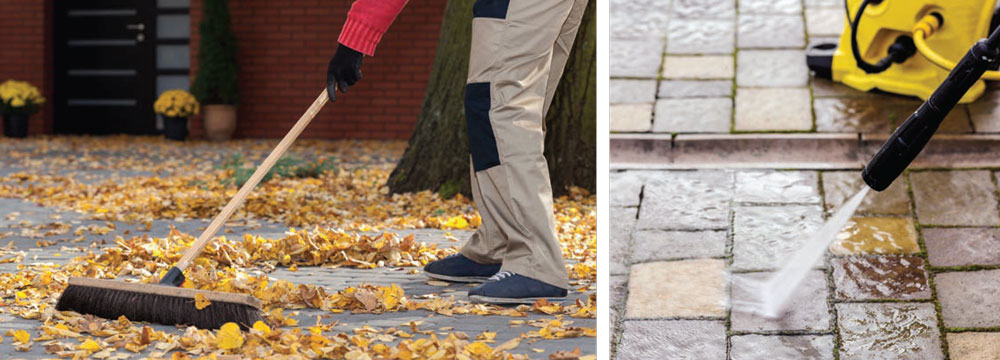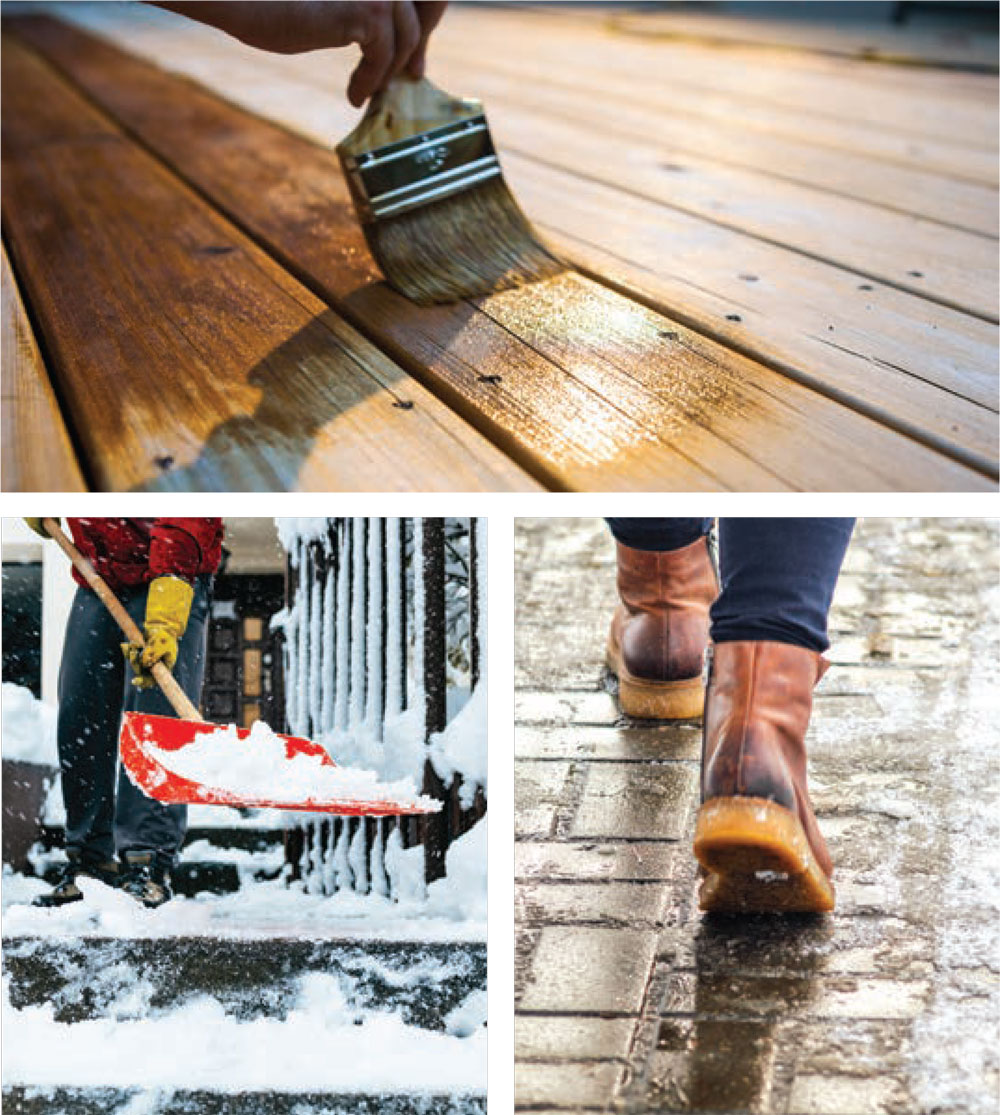WINTERIZE YOUR WALKWAYS

Protect Your Patio, Sidewalk, Deck & Porch this Winter Season
Virginia winter weather can really pack a punch for your home’s outdoor living areas. Before you know it, your beautiful porch, deck and walkways can start to lose their radiance and may begin to show signs of erosion due to snow and ice.
The best way to avoid these issues is to take the time to properly care for and winterize your outdoor spaces before the frigid temperatures set in for the season. Here are several ways to ensure your stone and wood surfaces are ready to face the winter ahead.
Thorough inspection
For starters, it is important to do a thorough inspection of your outdoor hard surfaces. Remove all of the outdoor furniture, pots and planters off of your deck, porch or walkways so that you have an unobstructed view of the space. Look for any signs of wood rot, broken stones, mold, mildew or loose nails and screws. Store all furnishings and planters away for the winter season, as these provide places for mold and mildew to grow.
If you come across any damage that is a quick and easy fix, now is the time to go ahead and address that. This will help with upkeep and make winterizing your outdoor spaces less of a hassle.
Clean is key
After you’ve attended to any minor damage on your outdoor hard surfaces, it’s time to do a clean sweep of these areas as well.
Clean up any debris lingering on your walkway, porch or deck. If left alone, this organic matter rests in cracks and crevices, seeds can germinate and cause issues. To keep this from happening, make it a priority to use an outdoor broom or leaf blower at least once a week to get rid of any leaves, branches or dirt that may have accumulated in corners and under deck furniture.
Jeremy Gordon, construction division salesman for Seven Oaks Landscape & Hardscape, Inc., says it’s also a good idea to keep leaves and debris off hard surfaces to prevent staining. “Clean outdoor surfaces with a low pressure power washer and the appropriate cleaner rated for that material,” Gordon says.
Gordon also recommends using a product like Wet and Forget, to help eliminate mold and mildew staining. Re-treat with Wet and Forget once a month to keep away moss, mold, mildew and algae.
Seal it up!
According to Gordon, the single best thing you can do to protect the look and feel of your stone or concrete walkways and patios is to use a good penetrating sealer and close off the internal pores of the material. “This keeps moisture, salts and other chemicals from being absorbed into the material itself,” Gordon says. “This greatly reduces the effects of freeze-thaw cycles.”
It’s important to have your wooden decks sealed, too. “Keep all wood decks re-sealed every three years,” Gordon says. “This keeps moisture and chemicals out, which swell in the wood fibers with freeze and thaw cycles. It also helps block UV rays that damage the wood.”
After you’ve cleaned and properly sealed your outdoor hard surfaces, the next most important step is to keep your porch, deck and walkways clear of snow and ice.
Snow, ice and freezing rain
When the frigid temperatures pose the possibility of winter precipitation, you may be wondering what the best course of action is for your outdoor space. Should you salt your surfaces? Shovel the snow and ice away? Or, simply let mother nature do her thing and melt the snow and ice naturally?
“I do not recommend using rock salt (sodium chloride) on any of those surfaces,” Gordon said. Instead he suggests using calcium chloride, which is safe for wood, stone, concrete and composite decking; it is also safe to use around children and pets. “There is also calcium magnesium acetate, which keeps the snow from bonding to surfaces so it is more easily removed by shoveling,” Gordon says.
Use a shovel that is made from plastic materials, as the metal ones tend to scratch up hard surfaces.
Keeping snow and ice off your deck prevents damage to the wood. When snow and ice melts and refreezes, it can keep the wood on your deck wet for days, leaving opportunities for mold, rot and mildew. It can also result in the paint or staining on your deck to chip and fade. When shoveling your deck, make sure you go against the grain with a plastic shovel so as not to scratch the deck.
“Ice is by far the most common and problematic form of winter weather we get [in this area],” Gordon said. But don’t let the ice get you down this winter season. By putting in the time and effort to prep and winterize your outdoor space now, you can get yourself one step ahead of the snow and ice so you can enjoy the winter season. ✦
deck, freezing rain, frigid temperatures, gutter downspout, hard surfaces, ice, natural stone, outdoor spaces, porch, sealer, snow, surface drains, Walkways, winterize









